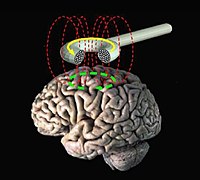
Photo from wikipedia
Question Transcutaneous vagal nerve stimulation (TVNS) is a promising treatment for acute and chronic pain ( Busch et al., 2013 ), however the testing of TVNS within the experimental pain… Click to show full abstract
Question Transcutaneous vagal nerve stimulation (TVNS) is a promising treatment for acute and chronic pain ( Busch et al., 2013 ), however the testing of TVNS within the experimental pain models yielded controversial results ( Busch et al., 2013 , Laqua et al., 2013 ). The aim was to investigate the effect of TVNS on perception of repetitive heat pain stimuli (RHPS) in comparison with sham and placebo procedure in healthy volunteers. Methods Forty-nine participants (25 females) underwent 4 RHPS sessions within an interval of 48 h in-between. During each session, 90 heat stimuli of individual pain tolerance temperature (ramp rate 20 °C/s, pulse duration 0.8 s, frequency of stimulation 0.33 Hz) were applied to the forearm using a CHEPS thermode (Medoc, Israel). The first (baseline) session was performed without intervention, during three following sessions either TVNS, sham (earlobe stimulation) or placebo condition were applied in a random crossover manner. Participants rated the perceived pain intensity of the first and each 10th stimulus using numeric rating scale 0–100. Data was analysed using ANOVA and Bonferroni adjusted multiple comparisons. Results Participants reported less pain during all interventional methods compared to baseline (p Download : Download high-res image (274KB) Download : Download full-size image ), whereas pain under TVNS was lower than under placebo procedure after 30 stimuli (p = 0.038, Fig. 1). The effect of TVNS and sham stimulation on RHPS perception was comparable. Conclusion We could confirm the hypoalgesic effects of TVNS, but these effects were not distinguishable from sham intervention in our study. However, we cannot exclude stimulation of cranial nerves during the placebo and sham condition because of possible acupressure effects and widespread neural activation after electrical stimulation of the earlobes.
Journal Title: Clinical Neurophysiology
Year Published: 2017
Link to full text (if available)
Share on Social Media: Sign Up to like & get
recommendations!